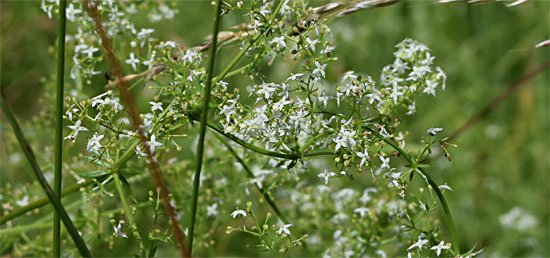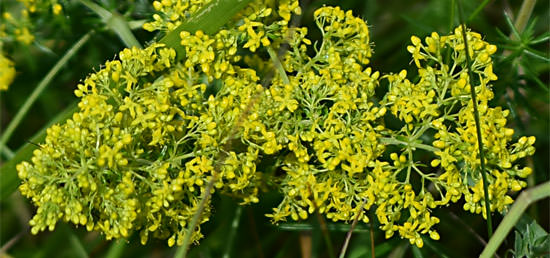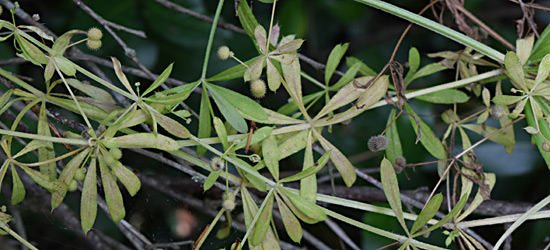Trapeharde is deep in the French countryside. The fields (champs) and hedges (haies) around it are rich in flowers (fleurs) and grasses (herbes) and even the least imposing of them can tell us something interesting. This blog post tells the story of three of them.
Galium mollugo
This one is also called hedge bedstraw or false baby’s breath.

Galium verum
This one is called lady’s bedstraw or yellow bedstraw.

Galium aparine
This one is known as cleavers, clivers, stickyweed or goosegrass. In old English, to cleave meant to glue, to stay close or to stick. It is also called velcro grass or grip grass.

This third grass is the one that children love to throw (jeter) at each other. When it lands on their clothes, it sticks (colle) to them rather than falling to the ground.
Uses
Two of these grasses have a special use. The word bedstraw indicates this. The grass was used as straw (paille) to stuff a mattress (matelas) or make a bed. If it was a bit scratchy, as is the case with hedge bedstraw, it was used for anyone’s bed. But if it was a soft, springy grass, as is the case with lady’s bedstraw, it was used for the bed of the lady of the house. Having this yellow grass in your matress had the added benefit of it acting as an insecticide.
The third grass, goosegrass, is eaten enthusiastically by geese (oies).
Names
| Latin name | English name | French name | Traditional use (usage) | Wikipedia |
|---|---|---|---|---|
| Galium mollugo | HEDGE BEDSTRAW false baby’s breath |
caille-lait blanc gaillet mou |
bedding | https://en.wikipedia.org/wiki/Galium_mollugo https://fr.wikipedia.org/wiki/Caille-lait_blanc |
| Galium verum | LADY’S BEDSTRAW yellow bedstraw |
caille-lait jaune gaillet vrai galium luteum |
bedding with insecticide properties | https://en.wikipedia.org/wiki/Galium_verum https://fr.wikipedia.org/wiki/Caille-lait_jaune |
| Galium aparine | GOOSEGRASS cleavers clivers stickyweed velcro grass grip grass |
gaillet gratteron rièble grateron gratte-langue trapeharde |
food for geese | https://en.wikipedia.org/wiki/Galium_aparine https://fr.wikipedia.org/wiki/Gaillet_gratteron |
Trapeharde’s special grass
See how appropriate it is that goosegrass has the old French name of trapeharde? It’s appropriate because there is an abundance of it in the fields around us.
A forested hillside next to the house is given this name. (You can see it on the relevant IGN map.)
As one of our visitors recently explained, it really does derive from Old French. The trap bit derives from attraper (to seize or to catch). The harde bit comes from the old French word clothes or rags or tatters. (Jeans with holes in the knees favoured by teenagers and film stars could be called hardes).
So, unlike some old houses deep in the countryside whose name nobody understands, our house’s name has a meaning! Be prepared, therefore, for us to throw some trapeharde at you when you visit us at Trapeharde!
